Top10 Virtualization Software Companies
Today most often they write about containers, but server virtualization software continues to dominate in data centers. Here are the "top ten" vendors offering the best currently virtualized software solutions.
Any discussions on server virtualization often end in high tones, go into an uncompromising dispute, but they almost always start with VMware, so we will begin our list of vendors of the best virtualization products for VPS from this company.

As for the actual software offerings of server virtualization, it is unlikely that you will need a deep knowledge of programming in order to profitably use all their components and sets of functions when the need arises. These solutions scale from multiple virtual machines (VMs) to host a small number of websites, virtual desktops, or intranet services to tens of thousands of VMs serving millions of Internet users. If the names of products from this list do not tell you anything yet, then it’s time to get to know them.
')
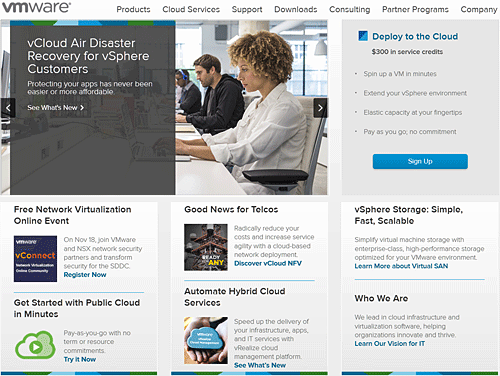
Try to find somewhere a data center that does not use VMware software. It is unlikely that you will be able to do this - there are very few such data centers. VMware dominates the server virtualization market, and this applies not only to its commercial VMware vSphere product. VMware also holds a leading position in the desktop virtualization software (VDI) market, and possibly in the free server virtualization segment with its VMware Server product. VMware retains leadership through innovation, strategic partnerships and highly reliable software products.

Microsoft has entered the market with the only non-Linux hypervisor Hyper-V product to compete successfully in the server virtualization segment, where VMware has already dominated the market. Firmly entrenched in the field of data centers, Microsoft currently offers an attractive Hyper-V licensing scheme and operating systems for it. For all Microsoft users, the Hyper-V product is a worthy solution that strengthens its competitive position with each release of the new release of Windows Server OS. Microsoft is also receiving increasing attention from companies that would like to use its Azure cloud services, and from organizations interested in the comprehensive management of Hyper-V services on their site for VPS hosting and Azure services.

Citrix, once the “lone wolf” in the application virtualization segment, is today the vendor of the world's most widely used cloud-based software, Xen (which is the basis of its commercial product, XenServer). Amazon uses Xen in its Elastic Compute Cloud (EC2) services, the same can be said about the cloud offerings of Rackspace, Carpathia, SoftLayer, etc. As for corporate clients, here are good examples - Bechtel, SAP and TESCO.

For the past 15 years, Red Hat has been recognized as a recognized leader in the industry and the Open Source community. Rated today as the most successful Open Source company, Red Hat came out into the world in 2008 when it acquired Qumranet, and with it a virtualization solution: KVM and SPICE (Simple Protocol for Independent Computing Environment). In December 2009, Red Hat released SPICE as an open source protocol. Its renowned server and workstation virtualization platform, Red Hat Enterprise Virtualization (RHEV) (now Red Hat Virtualization (RHV)), is based on the KVM hypervisor and Red Hat Enterprise Linux server operating system (RHEL). RHEV is based on open standards and works with Linux and Windows, and also supports enterprise applications such as SAP, SAS and Oracle applications.
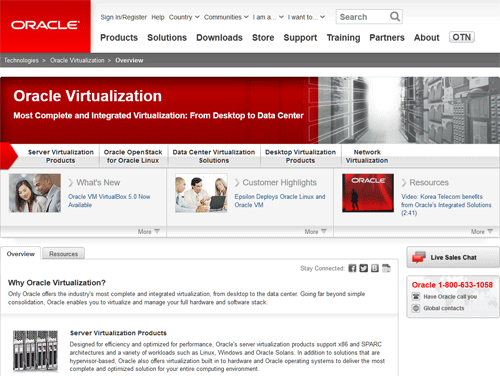
If Oracle's dominance in the enterprise-class database server segment does not impress you, then the purchase of Sun Microsystems has definitely made it a strong player in the virtualization market. In addition, Oracle owns its own OS (Sun Solaris), many virtualization software solutions (Solaris Zones, LDoms, and xVM) and server platforms (SPARC). What happens if you apply an insuperable force (Oracle) to a fixed object (DPC)? You will receive a data center based on Oracle.
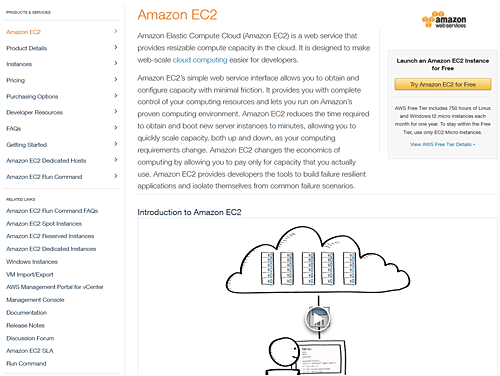
Amazon Elastic Compute Cloud (EC2) is a virtualization platform that has become the industry standard. Ubuntu Cloud Server supports seamless integration with Amazon EC2 services. EngineYard Ruby application services also use the Amazon cloud.

In a Google view, virtualization will obviously not be the first thing that comes to mind, but Google Apps, AppEngine and an extensive set of business services clearly demonstrate how the company has mastered cloud-oriented services.
Its open source Google Ganeti cluster server management software is implemented on top of existing virtualization technologies like Xen or KVM and essentially acts as a shell for these hypervisors, helping system administrators create cluster configurations.
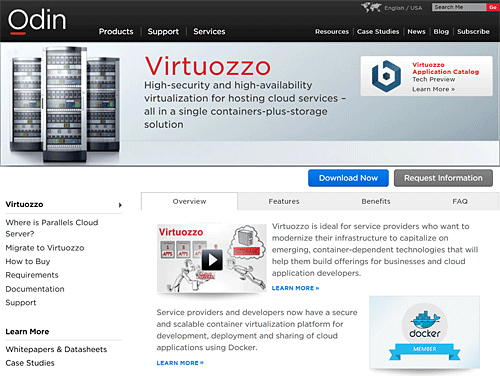
Parallels uses its Open Source OpenVZ project in a commercial product hosting virtual servers for Linux (Virtual Private Server, VPS). High VM density and low cost are the main things you'll hear when getting acquainted with the hosting solution based on Parallels software. The world's largest hosting companies choose Parallels for precisely these two main reasons. But progress in virtual hosting under Linux based on container virtualization is not in place. To maximize the number of Windows hosts per piece of hardware, Parallels also developed container virtualization tools for Windows. Although Parallels is still the most widely known for its desktop and application virtualization offerings, including Parallels Desktop and Server for Mac products, its provider business has undergone a rebranding and in March 2015 was renamed Odin, and Parallels Cloud Server was named Virtuozzo Virtuozzo allows you to run applications in separate lightweight containers, and Odin worked closely with Docker and Google on container standards.
The Odin brand and the Odin Service Automation directions in December 2015 were sold to Ingram and transferred to its management along with 500 employees involved in the development of the Odin Service Automation platform. Plesk and Virtuozzo were divided into separate companies, Parallels Holdings Limited remained their main owner. Virtuozzo, within the Parallels holding group, is now engaged in virtualization solutions.
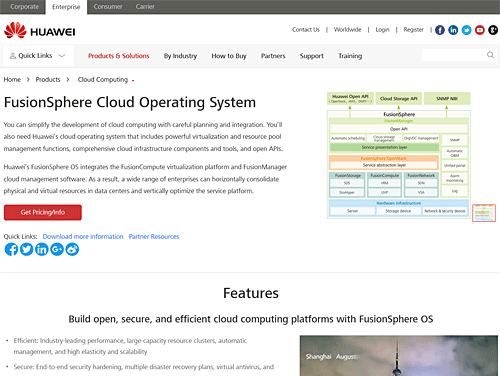
Huawei is one of the new players in the virtualization market, its corporate business was launched in 2011. Although the company is little known in the US, Huawei has a significant share in telecom and emerging markets in countries such as China, Brazil, Russia and India. Its infrastructure virtualization software, FusionSphere — Huawei’s core virtualization stack and cloud infrastructure product — is based on Xen. Like many leading virtualization providers, Huawei uses OpenStack in its FusionSphere and FusionCloud solutions.

Virtual Bridges is the company that invented what is now called the Virtual Desktop Infrastructure (VDI). Virtual Bridges VERDE allowed users to deploy Windows and Linux desktops in any infrastructure of 32-bit or 64-bit Linux servers on kernel version 2.6 or later (more on this in the VERDE corporate documents ). In February 2015, NIMBOXX acquired VERDE VDI from Virtual Bridges. Currently, NIMBOXX uses VERDE VDI technology as a ready-to-deploy solution for VDI workloads and in a wider offering, delivering software-defined “data center in a box” to companies with any number of employees.
It was a modified translation of the article .
Thanks for attention!
Any discussions on server virtualization often end in high tones, go into an uncompromising dispute, but they almost always start with VMware, so we will begin our list of vendors of the best virtualization products for VPS from this company.

As for the actual software offerings of server virtualization, it is unlikely that you will need a deep knowledge of programming in order to profitably use all their components and sets of functions when the need arises. These solutions scale from multiple virtual machines (VMs) to host a small number of websites, virtual desktops, or intranet services to tens of thousands of VMs serving millions of Internet users. If the names of products from this list do not tell you anything yet, then it’s time to get to know them.
')

1. VMware
Try to find somewhere a data center that does not use VMware software. It is unlikely that you will be able to do this - there are very few such data centers. VMware dominates the server virtualization market, and this applies not only to its commercial VMware vSphere product. VMware also holds a leading position in the desktop virtualization software (VDI) market, and possibly in the free server virtualization segment with its VMware Server product. VMware retains leadership through innovation, strategic partnerships and highly reliable software products.

2. Microsoft
Microsoft has entered the market with the only non-Linux hypervisor Hyper-V product to compete successfully in the server virtualization segment, where VMware has already dominated the market. Firmly entrenched in the field of data centers, Microsoft currently offers an attractive Hyper-V licensing scheme and operating systems for it. For all Microsoft users, the Hyper-V product is a worthy solution that strengthens its competitive position with each release of the new release of Windows Server OS. Microsoft is also receiving increasing attention from companies that would like to use its Azure cloud services, and from organizations interested in the comprehensive management of Hyper-V services on their site for VPS hosting and Azure services.

3. Citrix
Citrix, once the “lone wolf” in the application virtualization segment, is today the vendor of the world's most widely used cloud-based software, Xen (which is the basis of its commercial product, XenServer). Amazon uses Xen in its Elastic Compute Cloud (EC2) services, the same can be said about the cloud offerings of Rackspace, Carpathia, SoftLayer, etc. As for corporate clients, here are good examples - Bechtel, SAP and TESCO.

4. Red Hat
For the past 15 years, Red Hat has been recognized as a recognized leader in the industry and the Open Source community. Rated today as the most successful Open Source company, Red Hat came out into the world in 2008 when it acquired Qumranet, and with it a virtualization solution: KVM and SPICE (Simple Protocol for Independent Computing Environment). In December 2009, Red Hat released SPICE as an open source protocol. Its renowned server and workstation virtualization platform, Red Hat Enterprise Virtualization (RHEV) (now Red Hat Virtualization (RHV)), is based on the KVM hypervisor and Red Hat Enterprise Linux server operating system (RHEL). RHEV is based on open standards and works with Linux and Windows, and also supports enterprise applications such as SAP, SAS and Oracle applications.

5. Oracle
If Oracle's dominance in the enterprise-class database server segment does not impress you, then the purchase of Sun Microsystems has definitely made it a strong player in the virtualization market. In addition, Oracle owns its own OS (Sun Solaris), many virtualization software solutions (Solaris Zones, LDoms, and xVM) and server platforms (SPARC). What happens if you apply an insuperable force (Oracle) to a fixed object (DPC)? You will receive a data center based on Oracle.

6. Amazon
Amazon Elastic Compute Cloud (EC2) is a virtualization platform that has become the industry standard. Ubuntu Cloud Server supports seamless integration with Amazon EC2 services. EngineYard Ruby application services also use the Amazon cloud.

7. Google
In a Google view, virtualization will obviously not be the first thing that comes to mind, but Google Apps, AppEngine and an extensive set of business services clearly demonstrate how the company has mastered cloud-oriented services.
Its open source Google Ganeti cluster server management software is implemented on top of existing virtualization technologies like Xen or KVM and essentially acts as a shell for these hypervisors, helping system administrators create cluster configurations.

8. Parallels / Virtuozzo
Parallels uses its Open Source OpenVZ project in a commercial product hosting virtual servers for Linux (Virtual Private Server, VPS). High VM density and low cost are the main things you'll hear when getting acquainted with the hosting solution based on Parallels software. The world's largest hosting companies choose Parallels for precisely these two main reasons. But progress in virtual hosting under Linux based on container virtualization is not in place. To maximize the number of Windows hosts per piece of hardware, Parallels also developed container virtualization tools for Windows. Although Parallels is still the most widely known for its desktop and application virtualization offerings, including Parallels Desktop and Server for Mac products, its provider business has undergone a rebranding and in March 2015 was renamed Odin, and Parallels Cloud Server was named Virtuozzo Virtuozzo allows you to run applications in separate lightweight containers, and Odin worked closely with Docker and Google on container standards.
The Odin brand and the Odin Service Automation directions in December 2015 were sold to Ingram and transferred to its management along with 500 employees involved in the development of the Odin Service Automation platform. Plesk and Virtuozzo were divided into separate companies, Parallels Holdings Limited remained their main owner. Virtuozzo, within the Parallels holding group, is now engaged in virtualization solutions.

9. Huawei
Huawei is one of the new players in the virtualization market, its corporate business was launched in 2011. Although the company is little known in the US, Huawei has a significant share in telecom and emerging markets in countries such as China, Brazil, Russia and India. Its infrastructure virtualization software, FusionSphere — Huawei’s core virtualization stack and cloud infrastructure product — is based on Xen. Like many leading virtualization providers, Huawei uses OpenStack in its FusionSphere and FusionCloud solutions.

10. VERDE VDI
Virtual Bridges is the company that invented what is now called the Virtual Desktop Infrastructure (VDI). Virtual Bridges VERDE allowed users to deploy Windows and Linux desktops in any infrastructure of 32-bit or 64-bit Linux servers on kernel version 2.6 or later (more on this in the VERDE corporate documents ). In February 2015, NIMBOXX acquired VERDE VDI from Virtual Bridges. Currently, NIMBOXX uses VERDE VDI technology as a ready-to-deploy solution for VDI workloads and in a wider offering, delivering software-defined “data center in a box” to companies with any number of employees.
Comparison of virtualization products
| Vendor | License | VM per host | Customers | Type of virtualization | Controls |
| VMware vSphere Enterprise Edition | proprietary | 1025 | corporate segment | Full virtualization ⬝ hardware-assisted virtualization ⬝ paravirtualization | capacity planning // control ⬝ change reports ⬝ dynamic resource allocation ⬝ live migration ⬝ P2V conversion ⬝ performance metrics performance reports ⬝ power management ⬝ real-time notification shared resource pools ⬝ "thin" allocation of capacity (Thin Provisioning) ⬝ backup / restore VM ⬝ VM migration |
| VMware vSphere Standard Edition | proprietary | 512 | corporate segment | Full virtualization ⬝ hardware-assisted virtualization ⬝ paravirtualization | capacity planning / control ⬝ backup / restore VM |
| VMware vSphere ESXi Hypervisor | proprietary | 120 | small and medium businesses | Full virtualization ⬝ hardware-assisted virtualization ⬝ paravirtualization | ⬝ mapping configuration ⬝ dynamic resource allocation ⬝ fault tolerant configuration (failover) ⬝ live migration ⬝ "thin" allocation of capacity (Thin Provisioning) ⬝ virtual firewall |
| Microsoft Hyper-V Server 2008 R2 SP1 | proprietary | 318 | small and medium businesses | Full virtualization ⬝ hardware-assisted virtualization OS virtualization | capacity planning / control ⬝ change reports ⬝ configuration snapshots ⬝ dynamic resource allocation High Availability ⬝ VM live migration (Live Migration) performance reports ⬝ shared resource pools ⬝ Storage Migration ⬝ VM Migration |
| Microsoft Windows Virtual PC | proprietary | SMB | Full virtualization ⬝ hardware-assisted virtualization | ⬝ change reports | |
| Citrix xenserver | proprietary | 75 | ⬝ personal ⬝ SMB ⬝ corporate | ⬝ hardware-assisted virtualization ⬝ paravirtualization | resource management capacity planning / control ⬝ configuration snapshots High Availability ⬝ Live Migration performance reports ⬝ power management ⬝ Storage Migration ⬝ thin distribution of capacity (Thin Provisioning) ⬝ virtual firewall ⬝ VM migration |
| Citrix XenServer Free Edition | Open Source (free) | 1000 | ⬝ personal ⬝ SMB | ⬝ hardware-assisted virtualization ⬝ paravirtualization | resource management ⬝ mapping configuration ⬝ configuration snapshots ⬝ Live Migration performance reports ⬝ thin distribution of capacity (Thin Provisioning) ⬝ virtual firewall |
| Red Hat Virtualization 4.0 | Open source | 160 | corporate segment | Full virtualization ⬝ hardware-assisted virtualization ⬝ paravirtualization | resource management ⬝ configuration snapshots ⬝ live migration ⬝ performance metrics border migration ⬝ VM migration SP SPICE protocol for delivering virtual desktops (VDI) |
| Oracle solaris containers | proprietary | SMB | OS virtualization | ⬝ snapshots ⬝ VM live migration ⬝ P2V conversion | |
| Oracle VM Server for SPARC | proprietary | 128 | corporate segment | Full virtualization OS virtualization | ⬝ task automation capacity planning / control ⬝ snapshots of configurations ⬝ dynamic resource allocation ⬝ failsafe configurations (failover) ⬝ live migration ⬝ multiple host resource pools ⬝ power management ⬝ real-time notifications ⬝ shared resource storage pools ⬝ VM migration |
| Oracle VM Server for x86 5.0 | Open Source (free) | 128 | corporate segment | ⬝ hardware-assisted virtualization ⬝ paravirtualization | ⬝ task automation ⬝ power capacity / control ⬝ dynamic resource allocation ⬝ fault tolerant configurations (Failover, High Availability) ⬝ live migration ⬝ Servicing Mode (Maintenance Mode) ⬝ P2V conversion ⬝ power management shared resource pools storage migration ⬝ "thin" allocation of capacity (Thin Provisioning) ⬝ VM cloning ⬝ VM migration |
| Oracle VirtualBox 4.5 | proprietary | 128 | SMB, corporate segment | ⬝ hardware-assisted virtualization ⬝ paravirtualization | resource management ⬝ task automation ⬝ configuration mapping, fault-tolerant configurations (Failover, High Availability) ⬝ live migration ⬝ multiple host resource pools ⬝ P2V conversion shared resource pools ⬝ VM cloning |
| Amazon (Xen data) | Open source | 500 | SMB, corporate segment | ⬝ hardware-assisted virtualization ⬝ paravirtualization | resource management ⬝ "snapshots" of the configuration High Availability ⬝ live migration ⬝ service mode (Maintenance Mode) ⬝ performance metrics storage migration ⬝ VM cloning ⬝ VM migration |
| Google Geneti (KVM data; see also Xen) | Open source | personal, SMB | Full virtualization ⬝ hardware-assisted virtualization ⬝ paravirtualization | resource management ⬝ configuration snapshots ⬝ live migration ⬝ performance metrics border migration ⬝ VM migration | |
| Parallels Server Bare Metal | proprietary | SMB, corporate segment | Full virtualization ⬝ hardware-assisted virtualization OS-level virtualization | ⬝ task automation ⬝ live migration storage migration ⬝ VM migration | |
| Virtuozzo | proprietary | SMB | ⬝ hardware-assisted virtualization OS-level virtualization | ⬝ dynamic resource allocation High Availability ⬝ live migration storage migration | |
| Huawei FusionSphere OpenStack / FusionCloud (based on Xen / OpenStack) | Open source | SMB, corporate segment | ⬝ hardware-assisted virtualization ⬝ paravirtualization | resource management ⬝ "snapshots" of the configuration High Availability ⬝ live migration ⬝ service mode (Maintenance Mode) ⬝ performance metrics storage migration ⬝ VM cloning ⬝ VM migration | |
| VERDE Virtual Bridges | proprietary | corporate segment | Full virtualization ⬝ hardware-assisted virtualization ⬝ paravirtualization | ⬝ integrated backup ⬝ resource pools ⬝ task automation VM templates High availability (VM restart) |
It was a modified translation of the article .
Thanks for attention!
Source: https://habr.com/ru/post/309234/
All Articles